Treeset Class Java Example
1. Introduction
In this article, we will take a look at the Treeset class in Java using examples. TreeSet implements the SortedSet interface in Java which persists in a Tree. The ordering of the elements in a TreeSet is based on natural ordering.
2. TreeSet Java Example
TreeSet does not allow duplicate values. TreeSet persists the objects sorted in ascending order. It does not maintain the order the way the elements are inserted. The elements in the Treeset are sorted by the keys. TreeSet allows the insertion of homogeneous objects. TreeSet throws ClassCastException when you try to insert heterogeneous objects.It is a good choice for persisting sorted information. TreeSet provides quicker access and finds the elements in a short time. It is the implementation of a self-balancing binary search tree such as Red-Black Tree. The tree operations such as add, remove and search execute in O(Log m) time. Printing m elements in sorted order gets executed in O(m) time.
2.1 Prerequisites
Java 8 is required on the Linux, Windows or Mac operating system. Eclipse Oxygen can be used for this example.
2.2 Download
You can download Java 8 from the Oracle web site . Eclipse Oxygen can be downloaded from the eclipse web site.
2.3 Setup
2.3.1 Java Setup
Below are the setup commands required for the Java Environment.
Setup
JAVA_HOME=”/jboss/jdk1.8.0_73″ export JAVA_HOME PATH=$JAVA_HOME/bin:$PATH export PATH
2.4 IDE
2.4.1 Eclipse Oxygen Setup
The ‘eclipse-java-oxygen-2-macosx-cocoa-x86_64.tar’ can be downloaded from the eclipse website. The tar file is opened by double click. The tar file is unzipped by using the archive utility. After unzipping, you will find the eclipse icon in the folder. You can move the eclipse icon from the folder to applications by dragging the icon.
2.4.2 Launching IDE
Eclipse has features related to language support, customization, and extension. You can click on the eclipse icon to launch eclipse. The eclipse screen pops up as shown in the screenshot below:
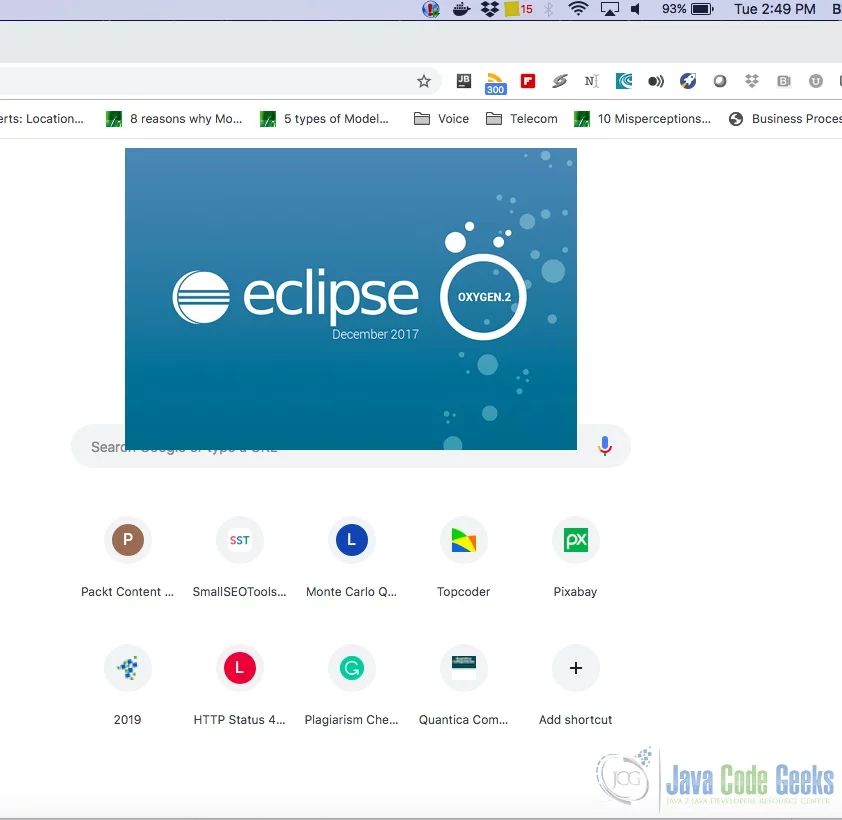
You can select the workspace from the screen which pops up. The attached image shows how it can be selected.
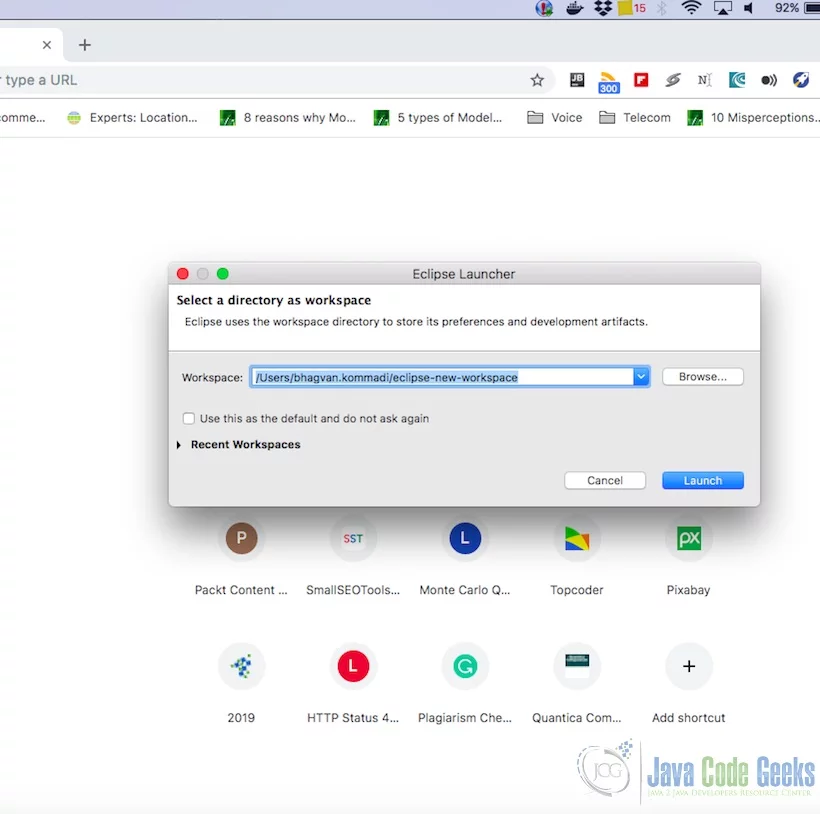
You can see the eclipse workbench on the screen. The attached screenshot shows the Eclipse project screen.

Java Hello World class prints the greetings. The screenshot below is added to show the class and execution on the eclipse.
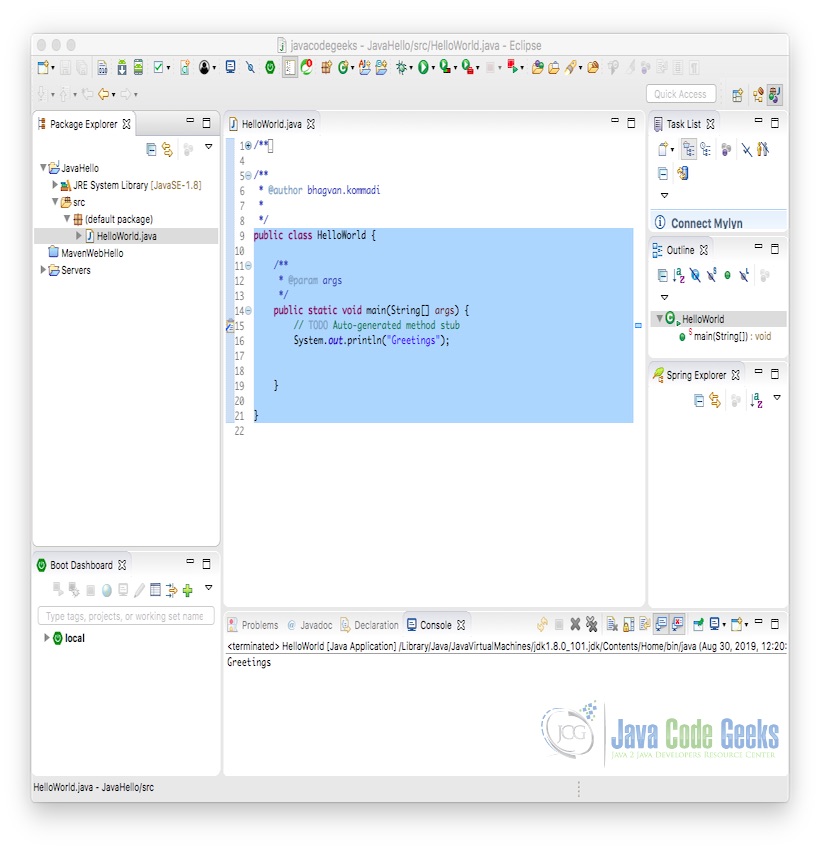
2.5 What is a TreeSet?
Java TreeSet implements the NavigableSet interface which extends SortedSet, Set, Collection and Iterable interfaces in the order of hierarchy. Java TreeSet can store unique elements similar to HashSet. It can find and retrieve the element in a short time. TreeSet does not allow null objects. It is non-synchronized.
2.6 Treeset Constructors
TreeSet‘s constructor without parameter is used to create the instance as shown in the example below.
TreeSet Constructor without param
Set treeSetInstance = new TreeSet();
TreeSet‘s constructor with parameter Comparable or Comparator is used to create the instance which can sort based on Comparator or Comparable as shown in the below example.
TreeSet Constructor with param Comparator
Set treeSetInstance = new TreeSet(Comparator.comparing(String::length));
TreeSet‘s constructor with parameter Collection is used to convert the Collection to a TreeSet as shown in the code snippet below.
TreeSet Constructor with param Collection
TreeSet treeSetInstance = new TreeSet(Collection collection);
TreeSet‘s constructor with parameter Sorted Set is used to convert SortedSet object to TreeSet in the code sample below.
TreeSet Constructor with parameter SortedSet
TreeSet treeSetInstance = new TreeSet(SortedSet sortedSet);
2.7 Examples of using TreeSet
Let us now look at the example of using TreeSet for adding elements and printing the elements in the TreeSet.
TreeSet Constructor with param
import java.util.TreeSet;
class TreeSetUsage {
public static void main(String[] args)
{
TreeSet treeSetInstance = new TreeSet();
treeSetInstance.add("element1");
treeSetInstance.add("element2");
treeSetInstance.add("element3");
treeSetInstance.add("element2");
Iterator iterator= treeSetInstance.descendingIterator();
while(iterator.hasNext())
{
System.out.println(iterator.next());
}
}
}
The output of the above code example when executed is shown in the screenshot below.
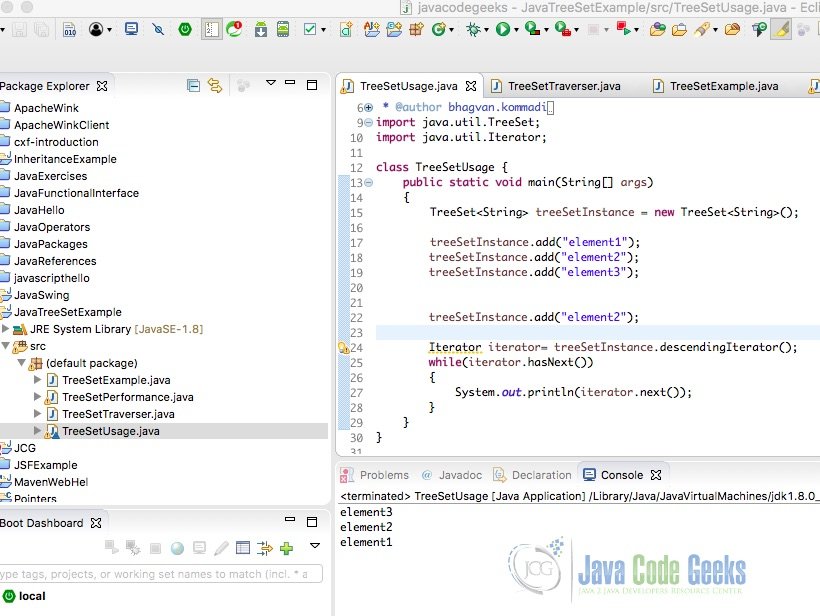
Now let us look at the example where we see the Treeset with Integer Elements.
TreeSet with Integer Elements
import java.util.TreeSet;
public class TreeSetTraverser {
public static void main(String[] args)
{
TreeSet treeSetInstance = new TreeSet();
treeSetInstance.add(1);
treeSetInstance.add(2);
treeSetInstance.add(3);
System.out.println("Highest Integer is "+ treeSetInstance.pollFirst());
System.out.println("Lowest Integer is "+ treeSetInstance.pollLast());
}
}
The output of the above code example when executed is shown in the screenshot below.
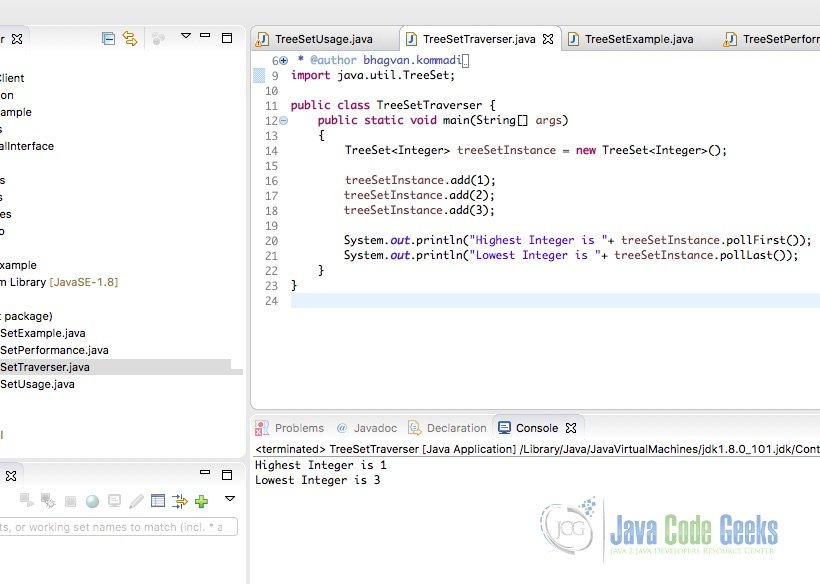
Let us look at TreeSet Example with Employee elements. Employee class has attributes id and name.
TreeSet with Employee Elements
import java.util.TreeSet;
import java.util.Set;
class Employee implements Comparable{
int id;
String name;
Employee(int id, String name) {
this.id = id;
this.name = name;
}
public int compareTo(Employee emp) {
if(id>emp.id){
return 1;
}else if(id<emp.id){
return -1;
}else{
return 0;
}
}
}
public class TreeSetExample {
public static void main(String[] args) {
Set employeeSet=new TreeSet();
Employee emp1=new Employee(1,"John Smith");
Employee emp2= new Employee(2,"William Brady");
Employee emp3= new Employee(3,"George Smith");
employeeSet.add(emp1);
employeeSet.add(emp2);
employeeSet.add(emp3);
for(Employee emp:employeeSet){
System.out.println(emp.id+" "+emp.name);
}
}
}
The output of the above code example when executed is shown in the screenshot below.
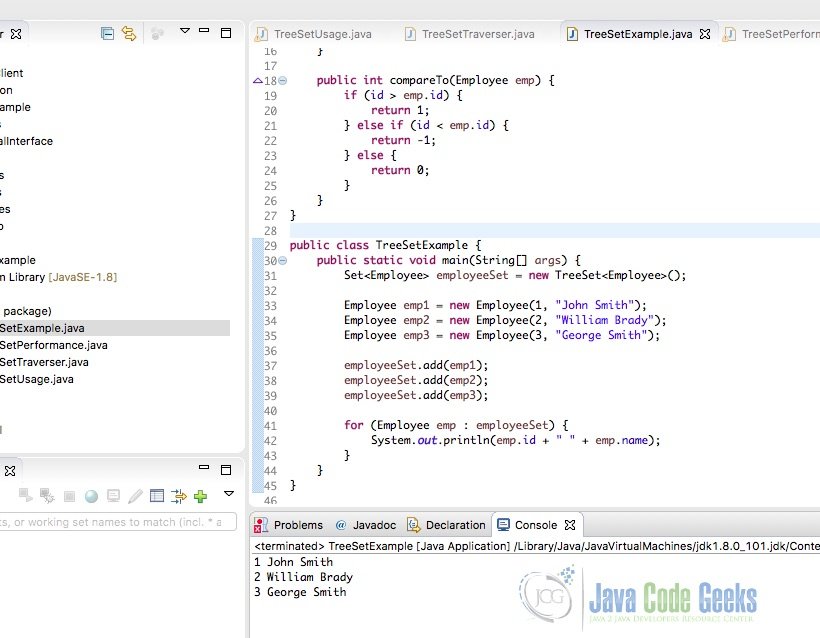
2.8 Choosing Treeset Instead of Other Data Structure
TreeSet is selected when the developer wants to preserve the order of elements of storage. The elements can be sorted alphabetically if the object representation is String or TreeSet is of the Generic type String. HashSet can be used if there is no sorting of the elements. It is also used if you want to store unique elements. TreeSet maintains the natural order and HashSet is used if there is no ordering of the elements.
2.9 Complexity of Operations
The TreeSet operations such as add, remove and search execute in O(Log m) time. Printing m elements in sorted order gets executed in O(m) time. Let us look at the example which shows to measure the execution time for different TreeSet operations.
TreeSet Performance
import java.util.TreeSet;
import java.util.Random;
import java.util.Iterator;
public class TreeSetPerformance {
public static void main(String[] args) {
Random rand = new Random();
TreeSet treeSetInstance = new TreeSet();
long startTime = System.nanoTime();
treeSetInstance.add("Element1");
long endTime = System.nanoTime();
long duration = endTime - startTime;
System.out.println("TreeSet adding time " + duration +" nano seconds");
startTime = System.nanoTime();
treeSetInstance.remove("Element1");
endTime = System.nanoTime();
duration = endTime - startTime;
System.out.println("TreeSet removing time: " + duration +" nano seconds");
treeSetInstance.add("element1");
startTime = System.nanoTime();
treeSetInstance.contains("element1");
endTime = System.nanoTime();
duration = endTime - startTime;
System.out.println("TreeSet search: " + duration +" nano seconds");
treeSetInstance.add("element2");
startTime = System.nanoTime();
Iterator iterator = treeSetInstance.descendingIterator();
while (iterator.hasNext()) {
System.out.println(iterator.next());
}
endTime = System.nanoTime();
duration = endTime - startTime;
System.out.println("TreeSet printing: " + duration +" nano seconds");
}
}
The output of the above code example when executed is shown in the screenshot below.
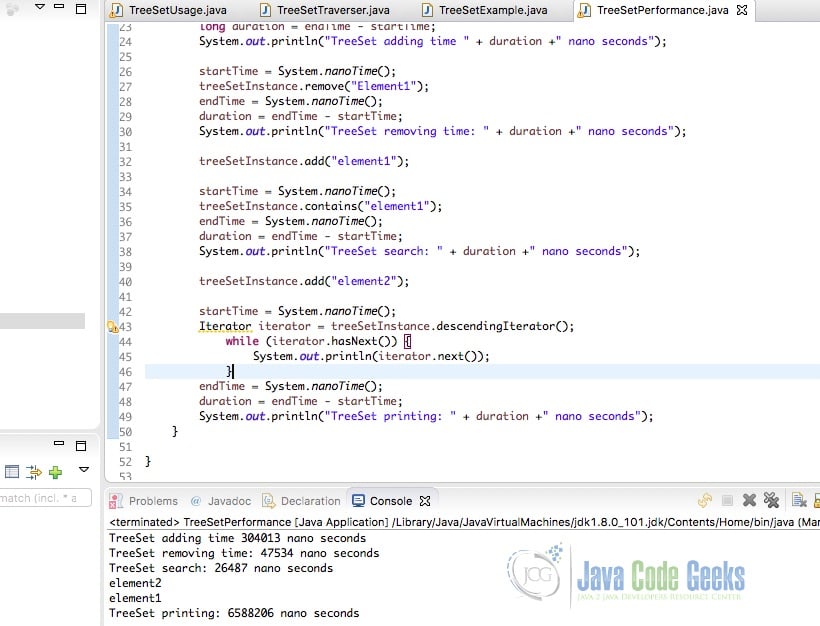
3. Download the Source Code
You can download the full source code of this example here: Treeset Class Java Example


